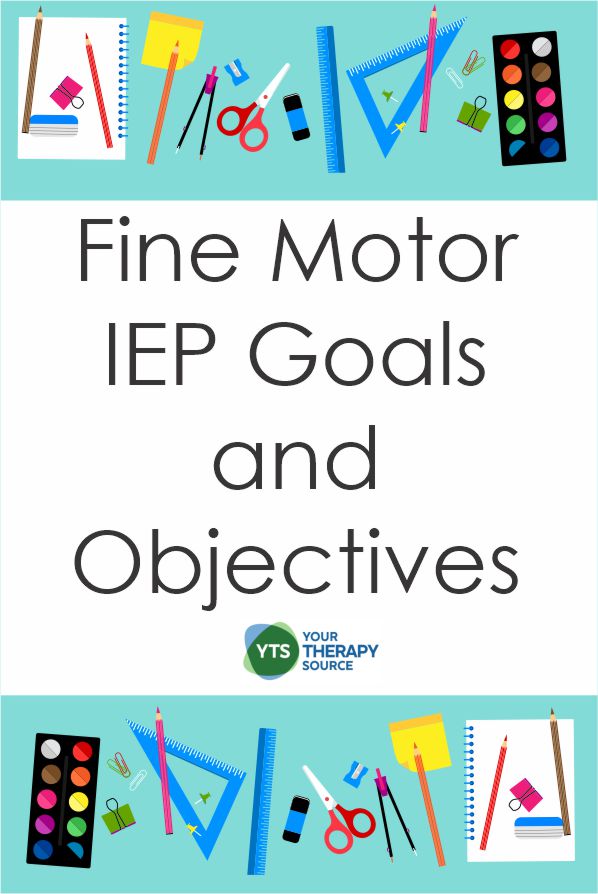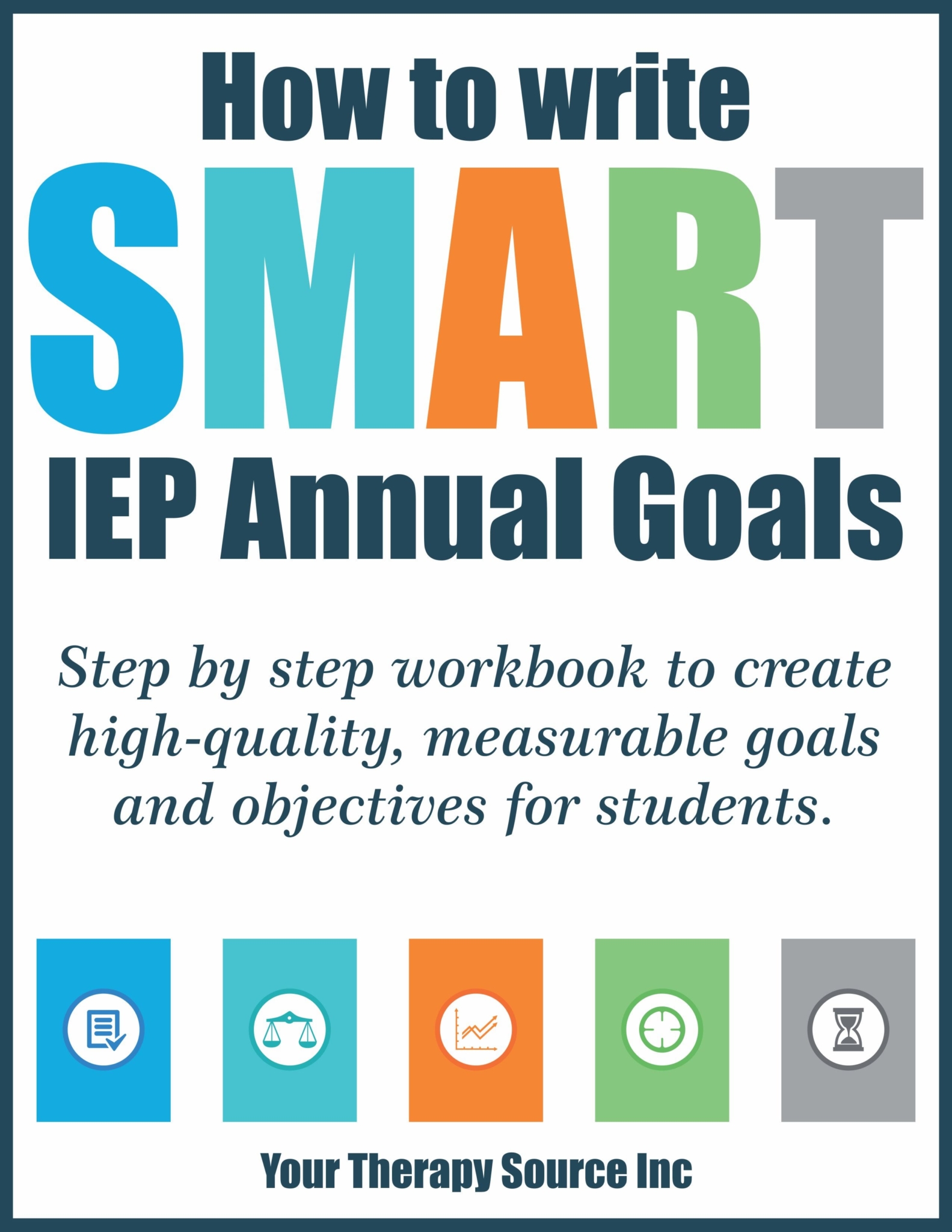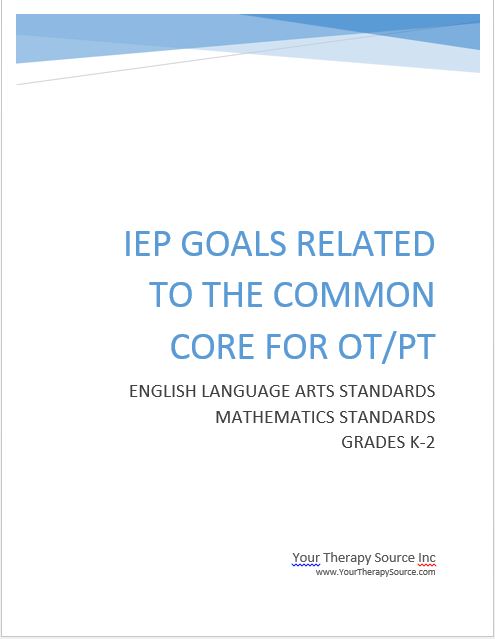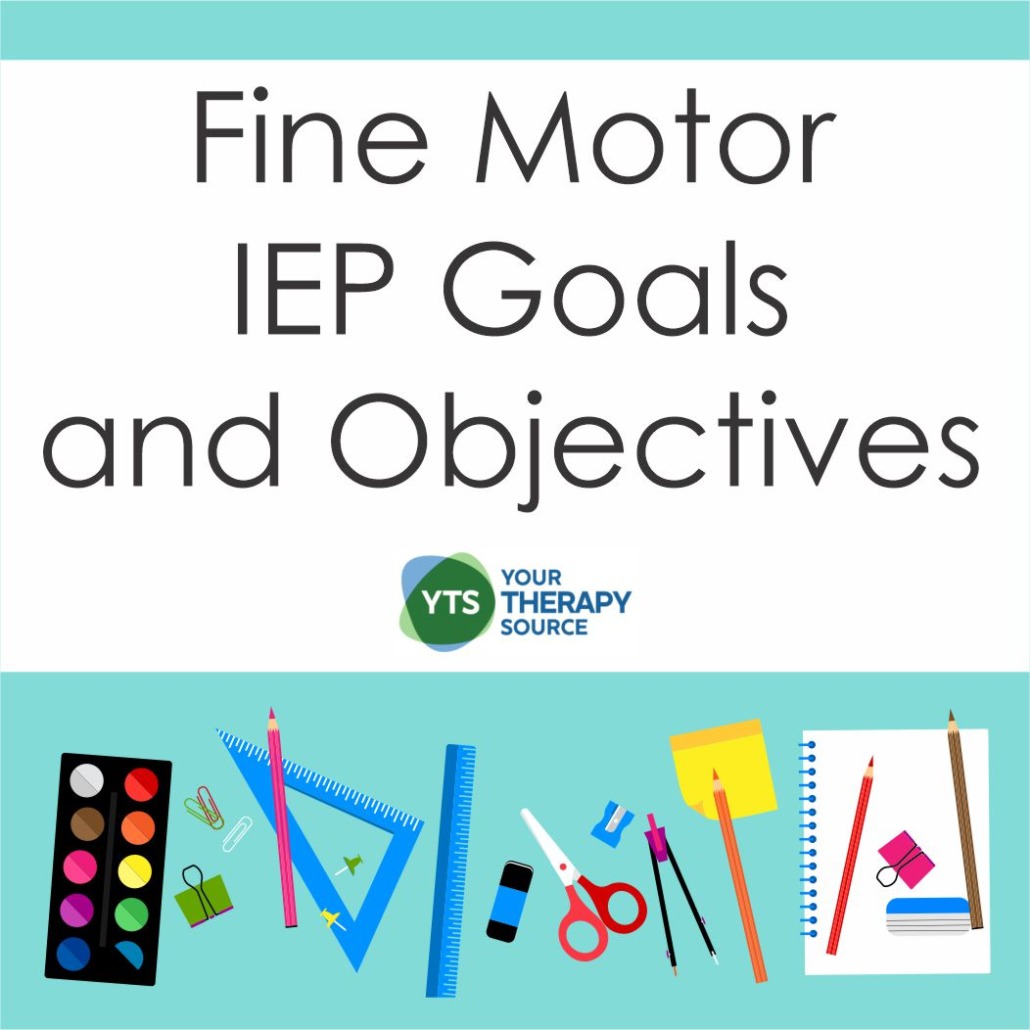FINE MOTOR IEP GOALS

Fine motor skills are needed in the classroom and in daily life. Children will receive an Individualized Education Plan (IEP) for fine motor problems in school once found eligible. Fine motor IEP goals give students a target to work toward in helping students meet their educational needs.
Children need strong hand muscles and a pincer grasp (pinching between the thumb and index finger) to learn to write. They need hand-eye coordination (eyes and hands working together) to feed and dress. Kids need bilateral coordination (using both sides of the body at the same time) to participate in two-handed coordinated tasks.
Once an IEP is established, an occupational therapist will work toward specific fine motor goals. Fine motor IEP goals need to be SMART goals to achieve success in special education services. These goals should be Specific, Measurable, Attainable, Relevant, and Time-bound to show progress.

How to Write IEP Goals Workbook
WHAT ARE EXAMPLES OF FINE MOTOR SKILLS NEEDED AT SCHOOL?
Good fine motor skills are necessary to keep up with peers in the classroom. These skills help students with activities such as handwriting, cutting with scissors, and self-care activities. Fine motor skills are an important part of a child’s development and should be encouraged from an early age.
HANDWRITING
Learning how to hold and use a pencil becomes an important skill for future classroom assignments. Strong fine motor skills lead to increased speed, endurance, and legibility in handwriting. Fingers rotate a pencil within the hand to use an attached eraser and twist a pencil when sharpening pencils.
CUTTING TASKS
Cutting is a visual motor activity that coordinates the eyes and the hands together to control and move the scissors. Strong hand strength helps open and close the scissors when participating in cutting activities. Cutting also builds finger strength and dexterity for future handwriting fine motor tasks.
SELF-CARE ACTIVITIES
Children need fine motor skills at school to tie shoes or manage clothing fasteners (i.e. buttons, snaps, or zippers). Feeding themselves with a fork or spoon at snack or lunchtime increases their confidence in interacting with their peers. Students also need good finger and hand strength to zipper and unzipper backpacks and open and close lunch containers.
FINE MOTOR IEP GOALS FOR PRESCHOOLERS
Goals that focus on the development of fine motor skills in preschool are common. Preschool is a time to draw with crayons, cut with scissors, and learn to manage buttons and snaps. Without fine motor skills, preschoolers can struggle with school activities and keeping up with their peers.
Goals for this age group focus on using one hand consistently to correctly hold crayons or markers and drawing lines and coloring shapes. Preschoolers learn to hold scissors safely and use them properly while incorporating their helper hand during cutting activities. Small object manipulation or the use of a variety of art tools independently such as glue sticks or paintbrushes, are also important.
The use of SMART goals also applies to preschoolers! Writing SMART goals makes writing fine motor goals easier. The following is a list of some fine motor IEP goal ideas for preschoolers:
- copy basic pre-writing strokes (vertical straight lines, horizontal straight lines, and circles)
- manipulate scissors to snip or cut out lines and simple shapes
- develop a functional grasp to hold a crayon/pencil properly
- use fingers to manipulate classroom objects using a correct functional grip
- use eating utensils appropriately during snack time
- manage fasteners on clothing throughout the school day (i.e. buttons, snaps, zippers, tie shoes)
SAMPLE IEP GOALS FOR FINE MOTOR SKILLS
IEP goals for fine motor skills need to be Specific, Measurable, Attainable, Relevant, and Time-bound (SMART) to show progress toward goals. Following SMART goal guidelines will save time and energy when completing all of that paperwork! Ask yourself these questions when writing each fine motor goal.
- Specific – What, why, and how will this specific fine motor goal help successfully impact the student’s performance within the classroom?
- Measure – How will you measure or monitor the student’s progress for success in this goal (i.e. data collection, observation, teacher report)?
- Attainable – Is the goal attainable and does the student have the skills to achieve this goal?
- Relevant – Is the goal relevant and important enough to the student for success in the school setting?
- Time-bound – When will you reach this goal or when is the deadline?
Here are a few examples of IEP goals to work on fine motor skills to get your mind automatically working toward the SMART goal way.
- Given a verbal cue, the student will independently demonstrate a functional tripod grasp with a writing instrument when performing classroom writing tasks, in 3 out of 4 opportunities observed over a 1-month period.
- Given a letter strip, the student will print 26 of 26 upper case letters and 50% of lower case letters of the alphabet with legible formation over 4 consecutive sessions.
- The student will independently cut out moderately complex shapes involving multiple angles, curves, and turns within 1/8 inch from the guidelines, in 3 of 4 opportunities over a 1-month period.
- The student will independently manage clothing fasteners (buttons, snaps, and zippers), in 3 of 4 opportunities observed over 4 consecutive sessions.
SAMPLE FINE MOTOR IEP GOALS RELATED TO ACADEMICS
Here are several SMART goals that focus on fine motor skills and academics:
- Student will be able to pick up objects from a desk top or any flat surface, 8 out of 10 trials, when manipulating materials to compose opinion pieces, informative text or narration by June.
- Student will write to compose text without complaints of fatigue 80 % of the time by March.
- When creating visual displays, student will use scissors correctly by holding in thumbs up position and cutting within 1/2” of a border 100% of the time by January.
- Using technology, (i.e. keyboard, adapted keyboard, mouse, tablet, etc.) student will be able to type at least 5 words per minute 100% of the time by June.
FINE MOTOR GOALS OCCUPATIONAL THERAPY
The strengths and weaknesses of students are considered when an occupational therapist writes fine motor goals. OT goals may change as students transition to different grade levels due to expectations and requirements in those grades. What may be a goal for a child in preschool may be achieved by the time the child gets to kindergarten. Goals need to be clear, straightforward, and progress to help students succeed in their learning environment.

IEP Goals Related to the Common Core for OT/PT
FINE MOTOR GOALS AND OBJECTIVES
Fine motor goals and objectives should include specific skills to meet the individual needs of the student. They also should include where the goal will take place (i.e. classroom), and the time frame and supports the student will require (i.e. prompts, cues). These goals need a component of measurement (i.e. teacher report, data collection) and accuracy (i.e. 80% of the time, 3 out of 4 opportunities). Strong fine motor IEP goals pave the way for academic success for students in the future!
RELATED POSTS
Daily Living Skills – Goals and Objectives

ARTICLE WRITTEN BY:
Kimberly Orlando, MOTR/L – Kimberly Orlando received her Master of Occupational Therapy from Chatham University in Pittsburgh, PA in 2001, and received her Level 1 Handwriting Specialist Certification through Handwriting Without Tears in 2012 in the areas of Pre-K Readiness, Printing, Cursive, and The Print Tool Evaluation. With 21 total years of experience as an Occupational Therapist, she has 6 years of experience providing services in hospital and home health care settings and 15 years of experience in early intervention and school settings (Pre-K through middle school levels). Kimberly also has experience tutoring children with fine motor and handwriting concerns.


